The AMD Radeon RX 480 Preview: Polaris Makes Its Mainstream Mark
by Ryan Smith on June 29, 2016 9:00 AM ESTPower, Temperature, & Noise
Given AMD’s focus on power efficiency with Polaris – not to mention the overall benefits of the move to 14nm FinFET – there is a lot of interest in just how the RX 480 stacks up when it comes to power, temperature, and noise. So without further ado…

When it comes to idle power consumption I'm posting the results I've measured as-is, but I want to note that I have low confidence in these results for the AMD cards. Ever since the GPU testbed was updated from Windows 8.1 to Windows 10, AMD cards have idled 3-5W higher than they used to under Windows 8.1. I believe that this is an AMD driver bug – NVIDIA’s cards clearly have no problem – possibly related to the GPU tested being an Ivy Bridge-E system. In this case I don’t believe RX 480’s idle power consumption is any higher than GTX 960’s, but for the moment the testbed is unable to prove it.
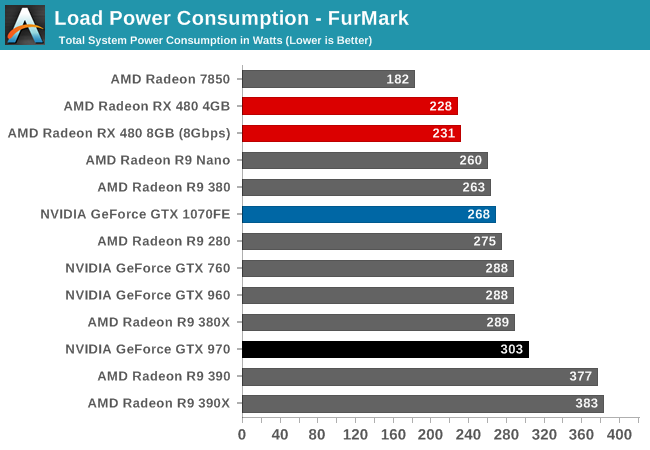
Traditionally we start with gaming load power before moving on to FurMark, but in this instance I want to flip that. As a power virus type workload, FurMark’s power requirements are greater than any game. But because it’s synthetic, it gives us a cleaner look at just GPU power consumption.
Among AMD’s cards, the RX 480 is second to only the Radeon HD 7850 in power consumption. Even then, as a GCN 1.0 card, the 7850 is one of the last AMD cards without fine-grained power states, so this isn’t a true apples-to-apples comparison. Instead a better point of reference is the GCN 1.2 based R9 Nano, which has a 175W TBP. Compared to the R9 Nano we find that the RX 480 draws about 30W less at the wall, which almost perfectly translates to the 25W difference in TBP. As a result we can see first-hand the progress AMD has made on containing power consumption with Polaris.
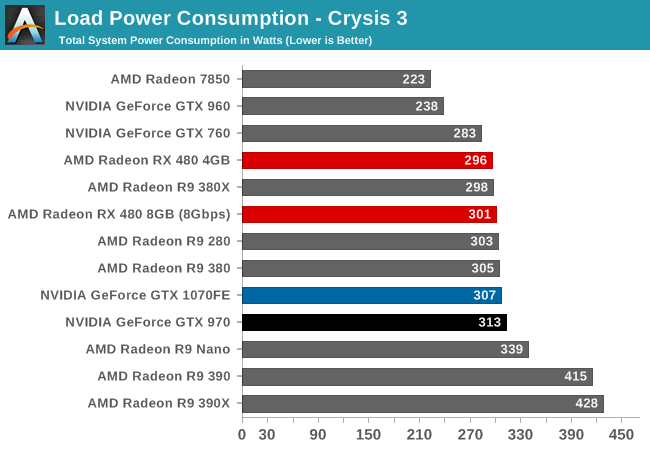
However things are a bit more mixed under Crysis 3. RX 480 is still near the top of our charts, and keeping in mind that higher performing cards draw more power on this test due to the additional CPU workload, the RX 480 compares very favorably to the rest of AMD’s lineup. System power consumption is very close to R9 280/380 for much improved performance, and against the performance-comparable R9 390, we’re looking at over 110W in savings. Hawaii was a solid chip from a performance standpoint, and Polaris 10 picks up where that left off by bringing down the power consumption to much lower levels.
The drawback for AMD here is that power consumption compared to NVIDIA still isn’t great. At the wall, RX 480 is only about 10W ahead of the performance-comparable GTX 970, a last-generation 28nm card. 1070FE further complicates matters, as its performance is well ahead of RX 480, and yet its power consumption at the wall is within several watts of AMD’s latest card. Given what we saw with FurMark I have little reason to believe that card-level power consumption is this close, but it looks like AMD is losing out elsewhere; possibly with driver-related CPU load.
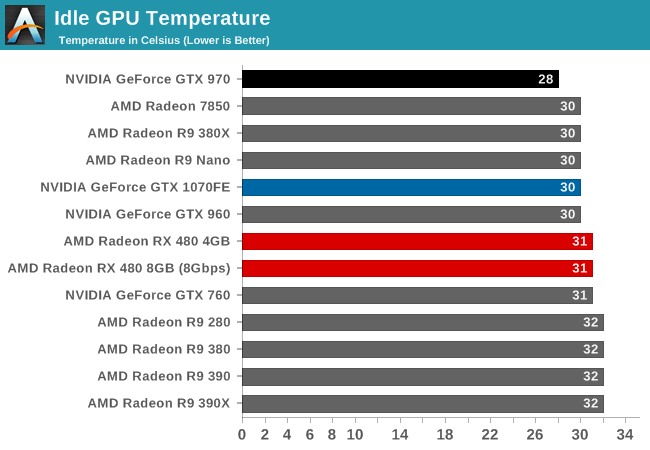
Moving on to idle GPU temperatures, there’s little to remark on. At 31C, the RX 480’s blower based design is consistent with the other cards in our lineup.
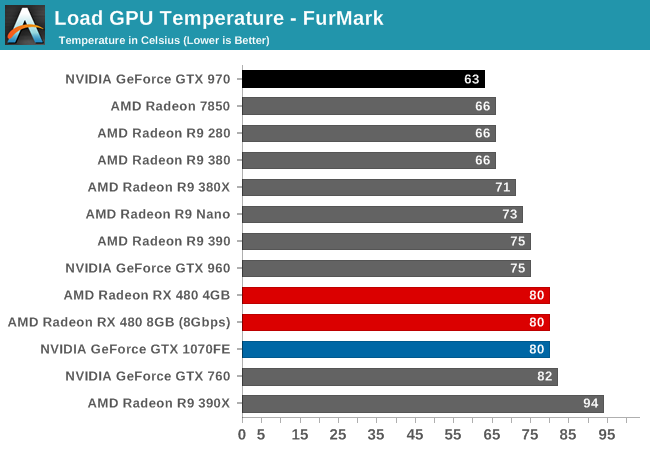
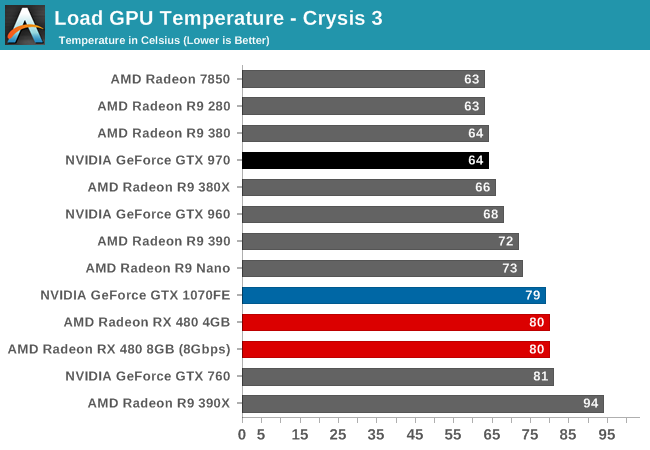
Meanwhile with load temperatures, we get to see the full impact of AMD’s new WattMan power management technology. The RX 480 has a temperature target of 80C, and it dutifully ramps up the fan to ensure it doesn’t exceed that temperature.

With idle noise levels RX 480 once again posts a good result. At 37.8dB, it’s in good company, only meaningfully trailing cards that idle silently due to their respective zero fan speed idle implementations.
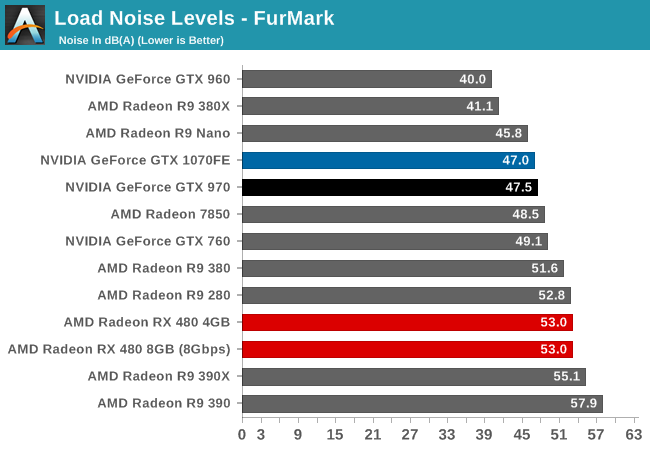
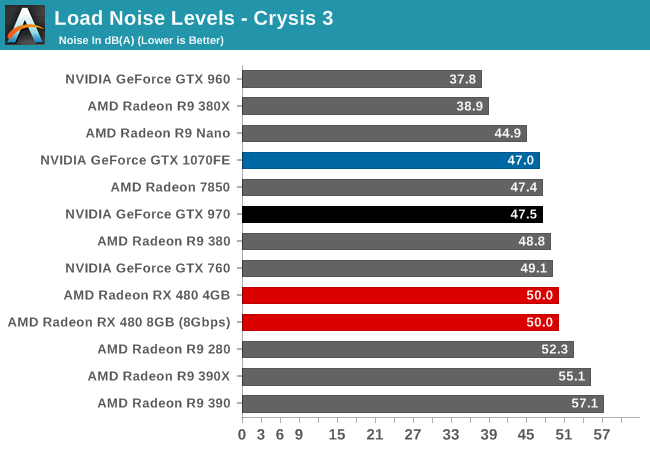
Finally, with load noise levels, RX 480 produces middling (but acceptable) results. Given that we have a mix of blowers and open air coolers here, the RX 480 performs similarly to other mainstream blower based cards. The $199 price tag means that AMD can’t implement any exotic cooling or noise reduction technologies, though strictly speaking it doesn’t need them.










449 Comments
View All Comments
Drumsticks - Wednesday, June 29, 2016 - link
I have heard this is true, but what does Anandtech (and many others) measure by? Most reviews show the 480 and the 970 very close in power draw.Polaris definitely appears to be a little bit more efficient than Maxwell, but likely less a good bit less efficient than Pascal. It's definitely better than the 3XX vs Maxwell days though.
looncraz - Wednesday, June 29, 2016 - link
Compared to the 970, the RX 480 has better power consumption for the performance, yes. Not by much, but that value should increase with AIB versions as the reference runs rather warm and has a less than efficient VRM.Only time will tell how that consumption changes with clock speeds and how much overclocking can be genuinely achieved from the chip, but at this point, stock vs stock, the RX480 is a better buy than the 970.
The 1060 is another matter altogether. It will certainly use less power and clock better than the RX 480, so we can assume that it will perform better as well - with nVidia simply tweaking its default clocks to best the RX 480. Still, it looks like the 1060 will have only 3GB or 6GB of RAM, so the cheaper RX 480 will fair better in RAM-heavy scenarios than the cheaper 1060.
just4U - Wednesday, June 29, 2016 - link
There is no guarantees on the 1060.. especially if it's 128bit. The 960 was a little on the disappointing side. Especially considering what you had to pay for it. (I know.. I own a 960 4G and a 380..)fanofanand - Thursday, June 30, 2016 - link
I wouldn't know how disappointing the 960 was, seeing as Anandtech never thought it worthy of review. *zing*gnawrot - Wednesday, June 29, 2016 - link
I am pretty sure that AMD can deliver Vega in 2017 if they want to. In the mean time they will release their server CPUs (more profitable market). They cannot launch that many products at the same time.Michael Bay - Wednesday, June 29, 2016 - link
Their server CPUs which nobody even wants. This particular battle was lost a decade ago.Domaldel - Thursday, June 30, 2016 - link
Not really if what we've heard about Zen is correct.32 cores and 64 threads with each core roughly matching Broadwell clock for clock at a lower price point?
While all of that could of course be bull there's also potential here for some serious disruption in the CPU market.
And Zen is probably higher priority for AMD then the GPU market as a whole.
Gigaplex - Thursday, June 30, 2016 - link
I doubt they'll match Broadwell clock for clock. They'll probably fall in the Nehalem to Sandy Bridge range. That should be enough though to cause some disruption in the CPU market if the price is right.mikato - Friday, July 29, 2016 - link
So are you saying, Michael Bay, that if they released a CPU that was competitive or better price-performance-efficiency and Intel's then it wouldn't be successful? It sounds like that is what you are saying.r@ven - Wednesday, June 29, 2016 - link
What are you stupid? The R9 390 was already made in the time to compete the 970. And even faster in 1440P.